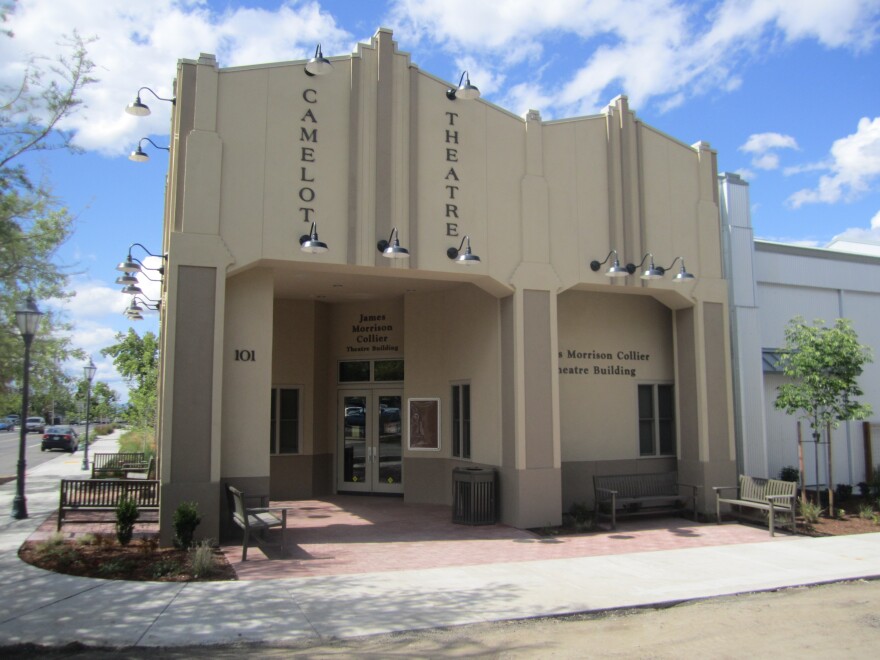Back in 2002, when LiviaGenise became Artistic Director of Actor’s Theatre in Talent, she expressed her interest in producing the musical Annie, and her desire to make musicals a vital element of the theatre’s repertory. She heard plenty of discouraging words. Their gist: the Rogue Valley lacked the performers necessary to support such an enterprise. Eleven seasons have passed since Annie played to resounding applause, and they have proved the naysayers wrong.
Actor’s Theatre has been renamed Camelot, an indication, perhaps, of Genise’s commitment to theatre as a force for positive social change. The remodeled feed store that entertained 8,000 patrons when she began has been left behind for the new James Collier Morrison Theatre Building, which features more seating, sophisticated technical capabilities, and dressing room space (what a concept!). Last year over 21,000 folks attended performances under its expanded roof. Throughout this change and growth, each season has devoted anywhere from one third to one half its offerings to works of musical theatre. Repeatedly Genise has demonstrated her genius for transforming large casts of all ages and levels of experience, from Equity veterans to novices, into denizens of its magical realms.
Camelot holds general auditions once a year, which continue to reveal the deep, often hidden bench of musical talent available locally. The process might discover a student venturing out from a theatre program at school; but it might just as well turn up a businesswoman, a dentist, or a paramedic. Or it might identify a performer with an impressive resume who just relocated to the Valley. Whether casting draws on ten-year-old kids or stage-seasoned adults into their seventies, selection means a rigorous commitment to twelve weeks of rehearsals and performances, with no time off. Believing strongly in the symbolism of paying actors, the theatre does give each performer an honorarium—still no one could be accused of taking on the Camelot challenge for the money.
In the past decade a strong core of performers and designers who thrive on this challenge has formed the bonds of a resident company. Says Genise, “These are the people I would trust to climb a mountain with.” Don Zastoupil, whose stunning set designs have enhanced Camelot productions since 2006, expressed the appeal of “the team aspect” of his work. “Everybody’s focused on the same thing. Everybody likes what they’re doing — that’s why they’re here.”
When you talk with Genise about her journey with Camelot, you note a recurring phrase—“she was ready to handle the choreography,” or “he was ready take on that role.” It signals an approach to making theatre that begins with the Camelot Conservatory, for kids 9–17 years old—a six-week summer camp whose mission is to train the next generation of theatre artists. Similarly Camelot mentors the development of all its artists, matching new tasks to learning curves, and encouraging the players to continue to stretch and polish their crafts.
The recent production of Evita exemplified Camelot at its best. It began with Genise sensing, “We were ready”—to handle the musical challenges of this popular opera. She herself had never had the opportunity to play Evita, though always wanted to and had definite ideas about the vision that should embrace the production. Rather than play up the sensationalism of Peron’s attraction to young girls and Evita’s manipulative ambition, she wanted to bring out the depth of their emotional relationship. It wasn’t simply two opportunists, but two hardened hearts who stumbled into a great love. The gadfly role of Che, too, became softer, more humanized, under Genise’s direction.
The staging required by opera happens often at the expense of direction. And performers can be leery of any upswelling of genuine emotion that might interfere with their voices. In this production, the lead singers became conduits for both the melodies and a full range of feeling. Add the live music of a five-piece orchestra in the wings (another hallmark of the Camelot musical), riveting choreography by Genevieve Andreaessen, and the succession of haunting historical images from designer Brian O’Connor, projected on the upstage wall. The result was the richly moving theatre experience that made it necessary for Genise to extend the run.
Now here’s a peek at some peaks on the Camelot horizon:
Livia Genise herself will be performing Loretta Lynn, January 9–19, in the next of Camelot’s popular “Spotlight” series—a little biography and a lot of music. Joining her for the Loretta-Conway Twitty duets, Bob Jackson Miner will also narrate and play the harmonica—though probably not simultaneously.
2014 is David Gabriel’s lucky year, and ours too. He will score a trifecta as Max in The Producers, Jean Valjean in Les Miserables, and Tevye in Fiddler on the Roof.
Genise is putting out an outrageous humor alert for The Producers. She promises that all shocked and indignant responses will be diffused by astonishment at the dancing.
Pat O’Scannell will star in “Spotlight on Edith Piaf,” singing all in French! Presila Quinby will narrate.
Three new directors will be flexing their chops next season!
Summer will bring another pop-opera to Camelot: the international smash-hit Les Miserables with its cast of thirty, made to look like thousands.
And in the distant future: Erik Connolly, who charmingly promoted his version of Evita’s story as Che, will play the part of Jesus in Jesus Christ, Superstar. By the way, it’s the box office success of Evita that made the high-ticket Superstar possible.
To stay abreast of all the things Camelot makes happen, you can visit the website at www.camelottheatre.org.
Molly Tinsley taught literature and creative writing at the U. S. Naval Academy for twenty years. Her latest book is the memoir Entering the Blue Stone (www.fuzepublishing.com)




